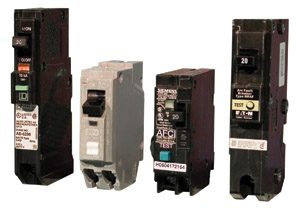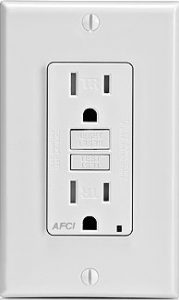Throughout the past 30 years, our homes have been largely transformed thanks to modern electrical devices. However, these helpful devices have also supported and contributed to the number of electrical fires throughout the U.S each year. Current homes are overwhelmed by today’s electrical demands, putting them at greater risk of arc faults and arc-induced fires.
What Is An Arc Fault?
An arc fault is a dangerous electrical problem caused by damaged, overheated, or stressed electrical wiring or devices. An arc fault occurs when older wires become frayed or cracked – possibly due to a nail or a screw behind a wall. It’s also common when outlets or circuits are overburdened carrying too large of a load. Think of a bolt of lightning, for example. Lightning is a very large and powerful arc that crosses from an electrically charged cloud to the ground, or another cloud. When an electric current in your home crosses to an energized component to a grounded component, a glowing discharged is formed called an arc. Just as lighting can cause severe damage, arcs produced in your home wiring are capable of producing high levels of heat that can ignite surroundings causing fires. In the U.S, arcing faults case more than 44,000 home fires each year. This results in hundreds of deaths, injuries, and millions in property damage.
What’s The Solution?

According to the Consumer Product Safety Commission, an arc fault circuit interrupter (AFCI) could help prevent more than 50% of the electrical fires that occur every year. AFCI’s are special electrical outlets and circuit breakers designed to detect and respond to potentially dangerous electrical arcs a home.
AFCI’s function by monitoring the electrical waves moving through your home and then interrupting the circuit they service if they detect changes in the wave pattern that may become a dangerous arc. They also are capable of distinguishing safe and normal arcs, like those that are created when a switch is turned on or a plug is pulled from an outlet. AFCI’s are extremely sensitive so that they can detect, recognize, and respond accordingly to extremely small changes in wave patterns.
Where Do Arcs Typically Form?
Arcs tend to form where wires are installed improperly or when insulation becomes damaged. In many older homes, wore insulation will eventually crystallize as it ages, becoming brittle and will crack and chip. Damaged insulation exposes wire to it’s surroundings, increasing the chances of arcing in your home.
Arcs May Occur In The Following Situations:
damaged electrical cords
damaged wire insulation due to nails and screws driven through walls
damaged appliance cords due to heat, aging, kinking, and over extension
liquid spills
loose connections in outlets, switches, and light fixtures
To Keep You And Your Home Safe From Fires, It’s Best To Have An AFCI In The Following Locations:
- Kitchen
- Family/Living Room
- Dining room
- Bedrooms
- Den/Office
- Hallways
- Closets
- Bonus/Play Rooms
 Each state has it’s own provisions based on the National Electrical Code requirements for AFCI protection in new homes. It is up to the home owner to know and understand what is available to protect your home and our family from electrical fires.
Each state has it’s own provisions based on the National Electrical Code requirements for AFCI protection in new homes. It is up to the home owner to know and understand what is available to protect your home and our family from electrical fires.
Depending on the size of a given home, the cost impact for installing additional AFCI protection is about $75 per circuit. That’s a small price to pay when it comes to saving your loved ones and your home from damage, injury, or death. There’s no doubt that AFCI’s provide advanced protection against electrical fires, but only if they are working properly. REember to reach out to your trusted Master Electrician to inspect and service your elctrical to ensure a safe and fire-free home.
Call Next Gen Electric today to get a FREE consult. We’re happy to take a look around your home to troubleshoot or provide peace of mind for you and your family.




 Each state has it’s own provisions based on the National Electrical Code requirements for AFCI protection in new homes. It is up to the home owner to know and understand what is available to protect your home and our family from electrical fires.
Each state has it’s own provisions based on the National Electrical Code requirements for AFCI protection in new homes. It is up to the home owner to know and understand what is available to protect your home and our family from electrical fires. 